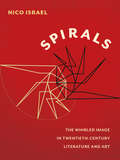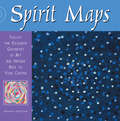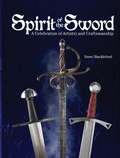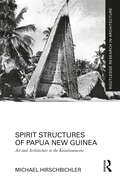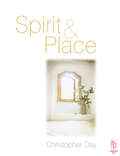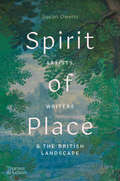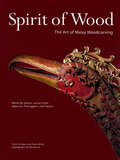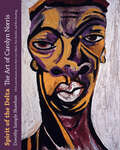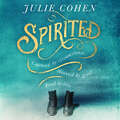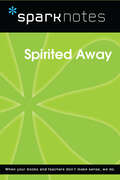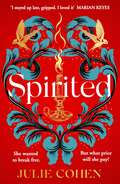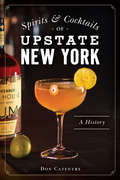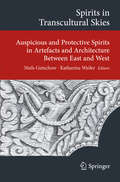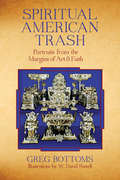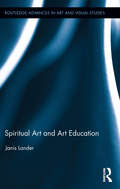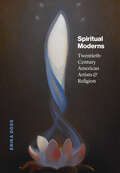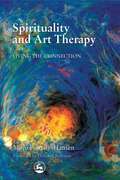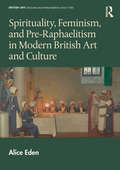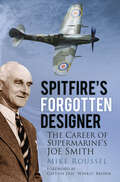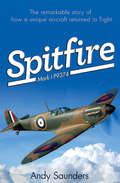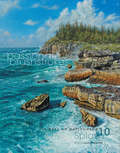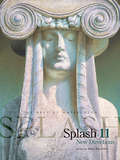- Table View
- List View
Spirals: The Whirled Image in Twentieth-Century Literature and Art (Modernist Latitudes)
by Nico IsraelIn this elegantly written and beautifully illustrated book, Nico Israel reveals how spirals are at the heart of the most significant literature and visual art of the twentieth century. Juxtaposing the work of writers and artists—including W. B. Yeats and Vladimir Tatlin, James Joyce and Marcel Duchamp, and Samuel Beckett and Robert Smithson—he argues that spirals provide a crucial frame for understanding the mutual involvement of modernity, history, and geopolitics, complicating the spatio-temporal logic of literary and artistic genres and of scholarly disciplines. The book takes the spiral not only as its topic but as its method. Drawing on the writings of Walter Benjamin and Alain Badiou, Israel theorizes a way of reading spirals, responding to their dual-directionality as well as their affective power. The sensations associated with spirals––flying, falling, drowning, being smothered—reflect the anxieties of limits tested or breached, and Israel charts these limits as they widen from the local to the global and recoil back. Chapters mix literary and art history to explore 'pataphysics, Futurism, Vorticism, Dada and Surrealism, "Concentrisme," minimalism, and entropic earth art; a coda considers the work of novelist W. G. Sebald and contemporary artist William Kentridge. In Spirals, Israel offers a refreshingly original approach to the history of modernism and its aftermaths, one that gives modernist studies, comparative literature, and art criticism an important new spin.
Spirit Maps: Follow the Exquisite Geometry of Art and Nature Back to Your Center
by Joanna Arettam"Spirit Maps" brings together two simple and profound ideas to help us find our centers: Art inspires and transforms us, calms us down in the midst of chaosChakra meditations focus our attention on the reservoirs of energy within and around usInspired by the labyrinths painted on the sidewalk outside her studio in lower Manhattan, Joanna Arettam decided to make a book of art and meditation using the colors of the chakras and the drawing power of mandalas as her guiding lights. She contacted hundreds of artists to choose the images for this book. They are presented here--five for each of the seven chakras--beginning with the Red Root Chakra. Red is for Instinct. It flows into orange, for Passion, yellow for Self-Esteem, green for Compassion (at the Heart Chakra), blue for Expression, violet for Wisdom, and purple for Spirituality. Arettam's lucid text introduces readers to mandalas and their power, to chakras, and to the transformative power of art. Seven brief chapters in all, with meditations for each chakra center. "Spirit Maps" is a perfect gift for any time, any season, any reason.
Spirit Of The Sword
by Steve ShacklefordLive the Legend. Feel the Steel Steeped in lore and legend, swords evoke images of samurai swordsmen, knights in shining armor, the glint of hardened steel, the charge of mounted cavalry. Spirit of the Word is a stunning visual journey through the history of the simplest and greatest weapon ever devised. More than 300 detailed photos of swords throughout the centuries and from around the worldScenes from the ancient swordmaking capitals of EuropeThe magic of the Japanese sword, including a profile of Yoshindo Yoshihara, the world's greatest living swordsmithSwords on the Big Screen: a cinematic exploration of sword mythology For the historian, for the collector, for the edged weapon enthusiast, Spirit of the Sword is the perfect one-volume guide to the history and mystique of the world's long blades. From, fascinating information on the history of swords from around the world to helpful tips on collecting and displaying swords, you'll find in Spirit of the Sword.
Spirit Structures of Papua New Guinea: Art and Architecture in the Kaiaimunucene (Routledge Research in Architecture)
by Michael HirschbichlerThis book investigates the art and architecture of Papua New Guinean spirit structures with a multi-perspectival approach that combines cultural and social sciences with building, architectural, and spatial research. It offers the first comprehensive study of the spirit houses of New Guinea that exists to date.The book’s aim is twofold: First, it aims to investigate the spirit structures and their associated cultural cosmos in detail. For this purpose, a representative selection of traditional buildings and artworks from different regions of Papua New Guinea is documented and analyzed, and theories for their understanding are formulated. In this course, the author develops a spatial theory of anthropological concepts – such as myths, signs, persons, and rituals. Secondly, this analysis is then situated in the broader context of the Anthropocene/Kaiaimunucene. Transforming the historical spirit structures into models for future-oriented cultural imagination, the consequences for contemporary productions of space and ways of worldmaking in light of existential challenges are traced.The book thus offers more-than-human and more-than-secular concepts for building, art, and worldmaking that are of critical importance in the ongoing Anthropocene/Kaiaimunucene. It will be of interest to researchers and students of architecture, anthropology, cultural studies, environmental humanities, and adjacent disciplines.Part I of the book was translated from German by Melanie Janet Sindelar.
Spirit and Place: Healing Our Environment, Healing Environment
by Christopher DayBuilt environment surrounds us for 90% of our lives but only now are we realising its influence on the environment, our health, and how we think, feel and behave both individually and socially.Spirit & Place shows how to work towards a sustainable environment through socially inclusive processes of placemaking, and how to create places that are nourishing psychologically and physically, to soul and spirit as well as body. This book's unique arguments identify important, but often unrecognised, principles and illustrate their applicability in a wide range of situations, price-ranges and climates. It shows how to reconcile the apparently incompatible demands of environmental, economic and social sustainability; how to moderate climate to make places of delight, and realign social pressures so places both support society and maximise economic viability. Thought provoking and easy to understand, Christopher Day uses everyday examples to relate his theories to practice and our experience.
Spirit of Place: Artists, Writers And The British Landscape
by Susan OwensLyrical and compelling, Spirit of Place examines the British landscape as it’s portrayed in literature and art. English landscape painting is often said to be an eighteenth-century invention, yet when we look for representations of the countryside in British art and literature, we find a story that begins with Old English poetry and winds its way through history, all the way up to the present day. In Spirit of Place, Susan Owens illuminates how the British landscape has been framed, reimagined, and reshaped by generations of creative thinkers. To offer a panoramic view of the countryside throughout history, Owens dives into the work of writers and artists from Bede and the Gawain Poet to Thomas Gainsborough, Jane Austen, J. M. W. Turner, and John Constable, and from Paul Nash and Barbara Hepworth to Robert Macfarlane. Richly illustrated, including manuscript pages, early maps, paintings, film stills, and photographs, Spirit of Place is a compelling narrative of how we have been shown the British landscape.
Spirit of Wood
by Eddin Khoo David Lok Farish A. NoorIn Malaysia, woodcarvers are venerated as artists who have a mystical affinity with wood. This collection of over 250 photographs and line drawings explores the mystical connection between Malaysian woodcarvers and their craft.
Spirit of the Delta: The Art of Carolyn Norris
by Dorothy Sample ShawhanRaised in West Virginia, self-taught artist Carolyn Norris (b. 1948) moved as a young woman of twenty-one to Cleveland, Mississippi, a quintessential Delta railroad town on the famous blues Highway 61. To create one of her first paintings, she tore the wooden back off a dresser to use as a canvas. She painted with available house paint and completed the painting with face makeup. Thus began the realization of a passionate need to paint. Eventually, Norris came to serve as the visual griot of Cleveland. She has used a variety of media, painting on canvas, wood, paper, cardboard, glass, plates, tiles, sheets, floor covering, and mirrors. She also uses her garage door as a giant mural chronicling community events. In her extraordinary images, Norris shows daily black life in the modern Delta. Spirit of the Delta contains 115 color images pulled from Norris's twenty-five years as a painter. Her existing artwork has been photographed by noted local photographer Kim Rushing and copies of the works that no longer exist have been found whenever possible. The book features a biographical essay on Carolyn Norris by Dorothy Sample Shawhan and an essay on her artwork by critic Patti Carr Black, who places Norris within self-taught traditions. In an interview with folklorist Tom Rankin, which took place in 1991, Norris explains the centrality of art in her life.
Spirit of the West: The Art of Don Brestler
by Don Brestler Arjun GuptaA beautifully illustrated tribute to a remarkable, self-taught artist of the Canadian West. The 81 oil paintings by Brestler featured in this volume depict perennial and endearing aspects of the West - 'A Cowboy's Life', 'Wildlife', and 'Home on the Range'.
Spirited
by Julie Cohen'I stayed up late, gripped. An unusual, moving read. I LOVED it!' Marian Keyes'Haunting, tender and true - this story cast a spell on me' Kirsty Logan'This haunting story about the power of love will give you the shivers' Best 'Wonderfully written and evocative' Woman & Home----A moving and gripping story about three extraordinary women from the Richard & Judy recommended bestselling author Julie Cohen.Viola has an impossible talent. Her photographs seem to capture things invisible to the eye - only a leap of faith could mean they are real. Until one day a woman arrives in Viola's life and sees the truth - about her pictures, and about Viola. Henriette is a celebrated spirit medium, carrying nothing but her secrets with her as she travels the country. The moment she meets Viola, a dangerous connection is sparked - but Victorian society is no place for reckless women. Meanwhile, across the world, invisible threads join Viola and Henriette to another woman who lives in secrecy, hiding her dangerous act of rebellion in plain sight.Faith. Courage. Love. What will they risk for freedom?---Driven by passionate, courageous female characters, SPIRITED is your next unforgettable read!
Spirited Away (SparkNotes Film Guide)
by SparkNotesSpirited Away (SparkNotes Film Guide) Making the reading experience fun! SparkNotes Film Guides are one-stop guides to great works of film–masterpieces that are the foundations of filmmaking and film studies. Inside each guide you&’ll find thorough, insightful overviews of films from a variety of genres, styles, and time periods. Each film guide contains:Information about the director and the context in which the film was made Thoughtful analysis of major characters Details about themes, motifs, and symbols Explanations of the most important lines of dialogue In-depth discussions about what makes a film so remarkable SparkNotes Film Guides are an invaluable resource for students or anyone who wants to gain a deeper understanding of the great films they know and love.
Spirited: The spellbinding new novel from bestselling Richard & Judy author Julie Cohen
by Julie CohenFaith. Courage. Love. What would you risk for freedom? 'I stayed up late, gripped. An unusual, moving read. I LOVED it!' Marian Keyes'Haunting, tender and true - this story cast a spell on me' Kirsty Logan'Wonderfully written and evocative' Woman & Home, BOOK OF THE MONTH'This haunting story about the power of love will give you the shivers' Best---------Viola has an impossible talent. Searching for meaning in her grief, she uses her photography to feel closer to her late father, taking solace from the skills he taught her - and to keep her distance from her husband. But her pictures seem to capture things invisible to the eye . . .Henriette is a celebrated spirit medium, carrying nothing but her secrets with her as she travels the country. When she meets Viola, a powerful connection is sparked between them - but Victorian society is no place for reckless women.Meanwhile, on the other side of the world, invisible threads join Viola and Henriette to another woman who lives in secrecy, hiding her dangerous act of rebellion in plain sight.Driven by passionate, courageous female characters, SPIRITED is your next unforgettable read!Perfect for fans of other bestselling historical novels The Binding by Bridget Collins, The Familiars by Stacey Halls, and Once Upon a River by Diane Setterfield. ---------Praise for SPIRITED:'A testament to the enduring power of love' Sunday Mirror'Mindful, vivid, and strong Spirited explores death, grief, faith, class and gender, while at its heart relationships expand to make this such an engaging and rewarding novel' Love Reading'This vivid tale is simmering with passions - some more repressed than others' The People'A tender and haunting tale, this is a slow-burn read which sparks into flame, as passion kindles in the heart of her beautifully realised characters' Daily Mail'A thrilling, spooky tale that has all the ingredients of a bestseller' Cambridge Independent---------Praise for the Richard & Judy Bookclub Pick TOGETHER by Julie Cohen:'A bold, breathtaking and truly compelling love story' Lisa Jewell'Moving and beautiful' Joanna Cannon'One of the most beautiful and heart-breaking stories I've read' Emma Flint'Reminded me of One Day & The Time Traveler's Wife' Erin Kelly---------Praise for the Polari Prize 2019 longlisted novel THE TWO LIVES OF LOUIS & LOUISE by Julie Cohen:'Brilliant . . . I enjoyed it hugely' Marian Keyes'Hugely original and heartbreakingly real' Rosie Walsh'Not often does a story remind us of what beautifully complex creatures we are. Julie Cohen has given us that rare gift' Christina Dalcher'Elegant, thoughtful and powerful' Daisy Buchanan
Spirited: The spellbinding new novel from bestselling Richard & Judy author Julie Cohen
by Julie Cohen'I stayed up late, gripped. An unusual, moving read. I LOVED it!' Marian Keyes'Haunting, tender and true - this story cast a spell on me' Kirsty Logan'This haunting story about the power of love will give you the shivers' Best'Wonderfully written and evocative' Woman & Home----A moving and gripping story about three extraordinary women from the Richard & Judy recommended bestselling author Julie Cohen.Viola has an impossible talent. Her photographs seem to capture things invisible to the eye - only a leap of faith could mean they are real. Until one day a woman arrives in Viola's life and sees the truth - about her pictures, and about Viola.Henriette is a celebrated spirit medium, carrying nothing but her secrets with her as she travels the country. The moment she meets Viola, a dangerous connection is sparked - but Victorian society is no place for reckless women.Meanwhile, across the world, invisible threads join Viola and Henriette to another woman who lives in secrecy, hiding her dangerous act of rebellion in plain sight.Faith. Courage. Love. What will they risk for freedom?---Driven by passionate, courageous female characters, SPIRITED is your next unforgettable read!
Spirits and Cocktails of Upstate New York: A History (American Palate)
by Donald CazentreFrom the Hudson Valley to the Niagara River, Upstate New York has a long and grand history of spirits and cocktails. Early colonists distilled rum, and pioneering settlers made whiskey. In the 1800s, a fanciful story of a tavern keeper and a “cock’s tail” took root along the Niagara River, and the earliest definition of the “cocktail” appeared in a Hudson Valley paper. The area is home to its share of spirited times and liquid legends, and the recent surge in modern distilleries and cocktail bars only bolsters that tradition. Author Don Cazentre serves up these tales of Upstate New York along with more than fifty historic and modern cocktail recipes.
Spirits in Transcultural Skies
by Niels Gutschow Katharina WeilerThe volume investigates the visualization of both ritual and decorative aspects of auspiciousness and protection in the form of celestial characters in art and architecture. In doing so, it covers more than two and a half millennia and a broad geographical area, documenting a practice found in nearly every corner of the world. Its transcultural approach aims at gaining insights into cultural dynamics and consistent networks and defining new historical mindmaps; it examines reciprocal effects and aspects of interwovenness in art and architecture with a view to reconceptualizing their established realms. The collection opens a window on a phenomenon in the history of art and architecture that has never before been considered from this perspective. The book focuses on a transcultural iconography of aerial spirits, goddesses and gods in art history, pursuing a methodologically innovative approach in order to redefine and develop the practice of identification and classification of motifs as a means to understanding meaning, and attempting to challenge the categories defined by academic disciplines.
Spiritual American Trash: Portraits from the Margins of Art and Faith
by Greg BottomsIn Spiritual American Trash, Greg Bottoms goes beyond the examination of eight "outsider artists" and inhabits the spirit of their work and stories in engaging vignettes. From the janitor who created a holy throne room out of scraps in a garage, to the lonely wartime mother who filled her home with driftwood replicas of Bible scenes, Bottoms illustrates the peculiar grace in madness.Using facts as scaffolding he constructs intimate narratives around each artist, painting their poor and difficult circumstances on the outskirts of American society and demonstrating struggle's influence on their largely undiscovered art. Both mournful and celebratory, these profiles embrace these compulsive creators with empathy and visceral sensory details.Each sentence reads with the cadence of a preacher who engages the art of the spirit and passion that often strays into obsession. Raised in the working-class South as a devout Christian with a deeply troubled brother, Bottoms understands how these eight outsiders "made art for a higher power and for themselves."
Spiritual Art and Art Education: Spiritual Art And Art Education (Routledge Advances in Art and Visual Studies)
by Janis LanderThis book is a study of contemporary spirituality as it is practiced in the world today, characterized by its secular and inclusive nature, and applied to art and art education. It identifies the issues facing a formal introduction of contemporary spiritual concepts into a secular and multicultural arts educational environment. Lander begins by separating the notion of "the spiritual" from the study of organized religions. She uses examples of art from different cultures in contemporary spiritual systems, making the study a reference book for contemporary spirituality and spirituality in art education, with usable definitions and practical examples suitable for scholars in art and visual studies, art education, and contemporary spirituality.
Spiritual Moderns: Twentieth-Century American Artists and Religion
by Erika DossExamines how and why religion matters in the history of modern American art. Andy Warhol is one of the best-known American artists of the twentieth century. He was also an observant Catholic who carried a rosary, went to mass regularly, kept a Bible by his bedside, and depicted religious subjects throughout his career. Warhol was a spiritual modern: a modern artist who appropriated religious images, beliefs, and practices to create a distinctive style of American art. Spiritual Moderns centers on four American artists who were both modern and religious. Joseph Cornell, who showed with the Surrealists, was a member of the Church of Christ, Scientist. Mark Tobey created pioneering works of Abstract Expressionism and was a follower of the Bahá’í Faith. Agnes Pelton was a Symbolist painter who embraced metaphysical movements including New Thought, Theosophy, and Agni Yoga. And Warhol, a leading figure in Pop art, was a lifelong Catholic. Working with biographical materials, social history, affect theory, and the tools of art history, Doss traces the linked subjects of art and religion and proposes a revised interpretation of American modernism.
Spiritual Moderns: Twentieth-Century American Artists and Religion
by Erika DossExamines how and why religion matters in the history of modern American art. Andy Warhol is one of the best-known American artists of the twentieth century. He was also an observant Catholic who carried a rosary, went to mass regularly, kept a Bible by his bedside, and depicted religious subjects throughout his career. Warhol was a spiritual modern: a modern artist who appropriated religious images, beliefs, and practices to create a distinctive style of American art. Spiritual Moderns centers on four American artists who were both modern and religious. Joseph Cornell, who showed with the Surrealists, was a member of the Church of Christ, Scientist. Mark Tobey created pioneering works of Abstract Expressionism and was a follower of the Bahá’í Faith. Agnes Pelton was a Symbolist painter who embraced metaphysical movements including New Thought, Theosophy, and Agni Yoga. And Warhol, a leading figure in Pop art, was a lifelong Catholic. Working with biographical materials, social history, affect theory, and the tools of art history, Doss traces the linked subjects of art and religion and proposes a revised interpretation of American modernism.
Spirituality and Art Therapy: Living the Connection
by Michael Franklin Janis Timm-Bottos Mimi Farrelly-Hansen Catherine Moon Cam Busch Suzanne Lovell Bernie Marek Madeline Rugh Edit Zaphir-Chasman Carol SagarReflecting the increasing recognition of the importance of the spiritual in healing, Spirituality and Art Therapy is an exciting exploration of the different ways in which the spiritual forms an essential, life-enhancing component of a well-rounded therapeutic approach. The contributors are leading art therapists who write from diverse perspectives, including Christian, Jewish, Buddhist and shamanic. They explain how their own spiritual and creative influences interact, finding expression in the use of art as a healing agent with specific populations, such as bereaved children, emotionally disturbed adolescents, and the homeless. The relationships between spirituality and visual art, art therapy and transpersonal psychology are examined. Story and image are interwoven in the spiritual journeys of therapists and clients, and suggested creative exercises make this an accessible, practical resource for those who desire to understand and execute an holistic method of therapy. Arguing that art therapists can mediate between the sacred and the mundane, this pioneering book is an affirmation of the transformative power of art therapy.
Spirituality, Feminism, and Pre-Raphaelitism in Modern British Art and Culture (ISSN)
by Alice EdenThis book proposes new understandings of modern life in Britain by bringing constructs of female spirituality centre stage and examining three ‘forgotten’ artists identified with the Pre-Raphaelites and Victorianism. Thomas Cooper Gotch, Robert Anning Bell and Frederick Cayley Robinson are resituated squarely within the tumultuous social and cultural changes of the period. Becoming visible again, in more inclusive histories, allows such artists not only to re-inhabit but to reshape narratives of modernism, reanimating the scholarly discourse and creating a dynamic cultural history of modern Britain expressed through their striking visions of womanhood. This book will be of interest to scholars in art history, gender studies and British studies.
Spitfire's Forgotten Designer: The Career of Supermarine's Joe Smith
by Eric Brown Mike RousselThe Supermarine Spitfire was a classic design, well known for its efforts in defending British shores during the Second World War. However, while Reginald Mitchell is rightly celebrated for his original design of the Spitfire, the role of Joe Smith in the development of the Spitfire is often overlooked. Smith was an integral member of the design team from the earliest days, and on Mitchell’s death in 1937 he was appointed design office manager before becoming chief designer. Smith’s dedicated leadership in the development of the Spitfire during the war, as well as his efforts on post-war jet aircraft, deserve their place in history. Charting the fascinating history of Supermarine from 1913 to 1958, when the company ceased its operations in Southampton, shortly after Joe Smith’s death in 1956, this book tells its story through the eyes of apprentices and many other members of Smith’s team. Marvellous photographs add to the sense of what it was like to work under Joe Smith at the drawing boards of one of Britain’s most famous wartime aviation manufacturers.
Spitfire: Mark I P9374
by Andy SaundersThe true story of the recovery of a World War II plane shot down in France—and the effort to restore this historic aircraft. Spitfire is the fascinating story of the recovery of a Battle of France Spitfire Mk 1 from the sands of Calais during the early 1980s—and its subsequent return to the United Kingdom for rebuild and restoration to flying condition. The full history of the airframe from the factory to loss, the airplane&’s operational history with 92 Squadron, and the story of the pilots who flew it during its career are also told, as is the unfolding saga of its restoration and return to air—detailing its progress through the workshops right up to the first flight in 2011.
Splash 10 Passionate Brushstrokes: Passionate Brushstrokes (Splash: The Best of Watercolor)
by Rachel Rubin WolfFeatured artist Jerry Stitt contemplates that ''A painting is good not because it looks like something, but because it feels like something.'' The difference is passion '' the kind of energy, excitement and pure joy that pulses through every page of this book.A brilliant collection of the best watercolors being created today, Splash 10 explores "passion" through the work and words of 100 top contemporary painters. With each modern-day masterpiece, insightful firsthand commentary taps into the psyche of the artists to explore where their passion comes from, and where it leads them.These artists find the passion to paint in any number of places - a handful of peppermints, a rescued dog named Tugboat, visits to places where "even the walls have personality," and spectacular moments created by the warm late-afternoon sun partnering with rich, cool cast shadows. Some of them find passion in their materials (like rice paper) or in the very act of putting paint to paper, whether it be broad, wet strokes of pure color applied with big brushes and arm-swinging applications, or meditative, economical strokes.This edition of Splash is dedicated to discovering not only how today's artists create great watercolors, but what motivates them to be creative, work in this amazing medium, and portray the subjects they love.
Splash 11 - New Directions: New Directions (Splash: The Best of Watercolor)
by Rachel Rubin WolfWhen life, or the spirit of experimentation, or the whim of watercolor itself leads artists outside their comfort zone, conditions are favorable for something new and wonderful to happen. Splash 11: New Directions features 126 such somethings, representing the best watercolor work being created today.As intriguing as the paintings themselves, the artists talk about what inspired these new directions - anything from a trip around the world to a bowl of apples passed by a hundred times before. Find out how a workshop, a new brush, or a new perspective (like painting into the sun) injected these works with fresh energy, emotion and inner reflection.In true Splash tradition, the sheer diversity of work within is stunning - from thick, dark and dramatic to light, loose and washy . . . in some cases all in the same piece. You'll find work from favorite Splash watercolorists, along with quite a few new artists never before seen in print.Anyone who has a passion for art will appreciate the thrill of discovery and freshness of technique that fills these pages. For painters who aspire to keep their own art lives fresh and exciting, this work - and the stories behind it - offer powerful inspiration to change it up, stand in a new place, and paint that painting you think you can't.
